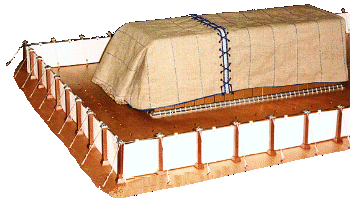| |

Goats were of particular importance on the Day of Atonement (Yom Kippur), the time when the children of Israel came together to be reconciled to God (Leviticus chapter 16). Two goats were selected by lottery, one for sacrifice and the other to be sent out into the wilderness. The blood of the sacrificed goat would be taken into the Holy of Holies by the High Priest, as required by God to forgive the sins of the children of Israel, for "without the shedding of blood there is no forgiveness" (Hebrews 9:22). Then the High Priest would lay his hands on the head of the other goat and confess all the sins of the children of Israel before it was sent out into the wilderness, signifying that God would forget all the sins thus confessed. Here is the origin of the 'scapegoat'.
The twofold significance of the goats is therefore that God wants to forgive and to forget. He desires to remove from His people not only the guilt of sin, but also His memory of that sin, so that we may be reconciled to Him.
For God's righteousness to be satisfied, though, one goat without blemish must die and the other goat without blemish must have the sins of Israel laid upon it and be removed outside the camp. All this speaks forward to the crucifixion of Jesus: "He who knew no sin was made sin for us" (II Corinthians 5:21), "He was manifested to take away our sins, and in Him there is no sin" (I John 3:5). Since Jesus is the reality of the two goats for our atonement and reconciliation to God, "we implore you on behalf of Christ, be reconciled to God" (II Corinthians 5:20).
The goats signify that the Sinless One has been made sin for us so that God can legally forgive us and no longer remember our sins, as it says in the New Covenant: "I will be forgiving of their unrighteousness and their sins I will remember no longer" (Hebrews 8:12). The covering of Woven Goat's Hair signifies that, if we have entered into the Tabernacle, we are clothed with Christ as our righteousness: "God made Him who knew no sin to be sin for us so that we in Him might become the righteousness of God" (II Corinthians 5:21). |
|
| .::top::. | |